Road Raging - Top Tips for Wrecking Roadbuilding
Chapter 12 - Tools for the Job
Direct action is an evolving art form -
"Necessity breeds ingenuity". Remember that the enemy have avidly read this
and every other similar guide, and will be constantly devising methods to beat
the "tools" described - so you MUST innovate, improve and invent. Your
imagination is the limit! Various different methods of obstruction can be used
in combination. Here are some ideas used now.
Locks
Padlocks and chains
put on gates cause confusion and may hold up work, while they run around
looking for the keys and then bolt croppers. Superglue or liquid metal in
their padlocks means that they have to cut off their own locks and keep buying
new ones.
 Bicycle D-locks
Bicycle D-locks
are a classic direct action tool. Get them from bike shops - the more you pay,
the stronger they are. They fit neatly around pieces of machinery, gates and
your neck. It is worth working in pairs when trying to lock on. The person to
lock on carries the U shaped section, and loops it around both a suitable
fixed piece of machine and their neck. Then their "buddy", carrying lock
barrel and key, secures the lock, and hides, or runs off with the key. If
locking on to a machine, someone must let the driver know that operating it
will break someone's neck. If locking on, you may be there for some time, so
choose your point carefully. They may remove any blankets or seats you have,
and isolate you from other protesters, sometimes forming a screen around
you.
You may want to keep a spare key about your person but they may search you
for it. If the buddy stays (with key) within earshot, then you can be released
in an emergency. It is important that anything you lock onto cannot be removed
or unscrewed. Gates can be removed from their hinges, so consider securing the
hinge side as well as the opening side. Most contractors have their own
hydraulic bolt croppers, which cut the strongest lock in seconds. The lock
gives a frightening jolt when cut, so don't lock on if you have a neck injury.
Locks are most effective on targets remote from croppers.
Handcuffs
are particularly good underneath machines if you can find inaccessible bits to
lock yourself to. They have also been used in tree evictions to attempt to
"capture" bailiffs. Loops of strong cord or tape can often be just as
effective and are cheaper. Decent handcuffs are difficult to find. Army
surplus or "sex shops" sometimes sell weak but expensive ones. Most handcuffs
can be undone with a standard key type, which security, police and bailiffs
often carry.
Thumb cuffs
(from army surplus shops) are quite good, pocket-sized and tricky to get off.
However, some would argue that contractors may take less care if it is just
your thumb locked on. Try to get double-locking ones which won't keep
tightening.
Coat loop lock-ons
These are effective, low tech and cheap. They work
by you wrapping your arms around something e.g. a tree or a vehicle axle, and
then putting your wrists through loops sewn into your coat lining, under your
armpits - right wrist to left armpit and vice versa. Coat loop lock-ons are
inconspicuous and mean you are always ready for action! Sew about a metre of
strong, tough material - old seat belts and climbing tape - into your coat
horizontally across the shoulder blades up to the armholes. Then double back
the excess and sew the ends very firmly into place to form loops. The bigger
the loops, the easier they are to find in a panicky situation. The smaller
they are, the harder it is for them to pull your hands out (although you can
twist the loops round and round so they tighten around your wrists). Practice
with them.
It works as the tape goes around your shoulder blades directing the
pressure around your back rather than on the coat. The loops are very
difficult to get to, being under your garments and under your armpits. They
may rip or cut your coat to get to them, so use an old coat.
Cherry-Picker Catchers
It would be lovely to see a "cherry-picker"
hydraulic platform locked to a tree or building during an eviction. To make a
cherry-picker catcher you will need several metres of strong chain or steel
cable that can't be cut by manual bolt croppers. The length will depend on the
height and method of attachment. The basic idea is to firmly attach one end to
a tree or building and then, during eviction, quickly lock the other end
through the cherry-picker basket. You will need to surprise and distract the
bailiffs.
Cable will require a loop at each end, secured with U-bolts with screw
threads mangled, so that they can't be undone. Get the best D-lock you can
afford and use it either to directly lock the end to the cherry-picker, or
loop the cable or chain around part of the bucket, locking it back to itself.
They shouldn't be able to cut this unless they start to carry expensive
hydraulic bolt croppers in every cherry-picker. If they do, throw them to the
floor. If they send another cherry-picker up to rescue the first, catch that
too!
Arm Tubes
Tubes made from plastic or metal piping, the diameter of a
clothed arm, are a versatile tool. They need to be the length of two arms,
ideally with a strong metal pin welded in the middle. Pairs of people with two
tubes can defend a small tree or immobilise a machine. You need to link your
arms together inside the tubes, either with handcuffs, or loops of strong cord
or climbing tape with karabiners, encircling the object. Be aware that if you
lock-on with handcuffs, you won't be able to release yourself.
A shorter tube can be used by one person around a digger arm or prop-shaft
for example. For comfort, pad the top of the tube, and keep your arm lower
than your heart to maintain blood flow. The number of people in arm tubes
determines how large an object you can encircle. If you lie down as a group of
say ten people (i.e. 10 tubes) with your feet in the centre of a circle, quite
a large area can be covered. Arm tubes have been used to blockade gateways,
roads and even airport runways. To remove you, they must cut the tube using
hacksaws or angle grinders. Once one tube is cut then the whole circle is
broken.
Lock-Ons
Concrete lock-ons, also called "dragons", are an advancing
technology. Set in chimney stacks, in houses, up trees, at the base of trees,
in oil barrels, in roads, in cars (immobilised or still drivable) and in
tunnels, they have delayed evictions by days. Mobile lock-ons pose a real
threat to free flowing infrastructure systems...
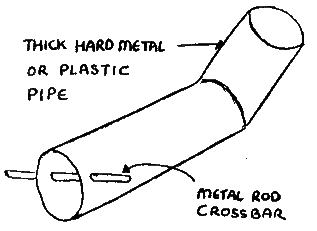 All lock-ons are constructed from an arm tube, with a metal
crossbar at the bottom, which is then set in concrete. The concrete mix, 1
part cement to 3 parts sandy aggregate, can be strengthened using washing up
liquid. Pieces of chopped-up tyres and metal mesh can be added to the mix to
hinder drilling out the concrete. Surround the cross bar and arm tube with
lots of metal, e.g. a car wheel. The concrete ideally needs months to set to
its full strenght. Make them well in advance. On some campaigns, gas canisters
have been conspicuously embedded in the lock-on, to deter use of power tools.
This has led to the police threatening arrest for explosives offences, so
those lock-ons were dismantled by protesters. When building, plan for a
comfortable locking on position.
All lock-ons are constructed from an arm tube, with a metal
crossbar at the bottom, which is then set in concrete. The concrete mix, 1
part cement to 3 parts sandy aggregate, can be strengthened using washing up
liquid. Pieces of chopped-up tyres and metal mesh can be added to the mix to
hinder drilling out the concrete. Surround the cross bar and arm tube with
lots of metal, e.g. a car wheel. The concrete ideally needs months to set to
its full strenght. Make them well in advance. On some campaigns, gas canisters
have been conspicuously embedded in the lock-on, to deter use of power tools.
This has led to the police threatening arrest for explosives offences, so
those lock-ons were dismantled by protesters. When building, plan for a
comfortable locking on position.
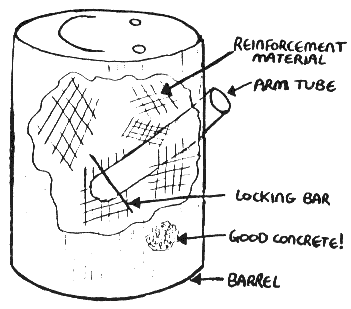 If you're making lots of lock-ons over a large area in a short
time, a mobile concreting team with a small mixer might be a sensible way to
organise. Ideally, the person who makes the lock-on should be the person who
uses it. Try to keep the location of lock-ons quiet and perhaps have one show-
piece lock-on to demonstrate to new people.
If you're making lots of lock-ons over a large area in a short
time, a mobile concreting team with a small mixer might be a sensible way to
organise. Ideally, the person who makes the lock-on should be the person who
uses it. Try to keep the location of lock-ons quiet and perhaps have one show-
piece lock-on to demonstrate to new people.
To lock-on, put your arm down the arm-tube and use climbing tape (perhaps
reinforced with wire) plus a karabiner, or anything strong and comfortable
which can join your arm to the cross bar. The bailiffs will remove you if they
can without actually cracking the lock-on. They often stick a hooked blade on
a pole down the tube, to cut any cord or tape attaching you to the lock-on.
Fibre-optic remote scopes have been used to see what your arm is attached
with. Padding the arm-tube with foam, fabric, cardboard etc, can hinder this.
Of course they may tickle you, use threats and intimidation or inflict pain
using pressure points or twisting your arm until you unlock yourself. If you
are up a tree, they may light fires underneath you to smoke you out.
If they can't get your arm out, they will firstly use an angle-grinder or
similar to cut through any outer barrel or other metal coating, then use small
pneumatic drills to get through the concrete. They will then need to cut
through the arm tube - probably using an angle-grinder. Try surrounding the
arm tube with several concentric tubes of increasing diameter, with the spaces
filled with concrete to slow their progress further. All this should take
quite a while, and will be noisy, dusty and scary. Have your own goggles, ear
plugs and dust mask. Prepare for a long stay with food, water and warm
clothes. Lock-on at the very last moment as it can be uncomfortable, and go to
the loo first!
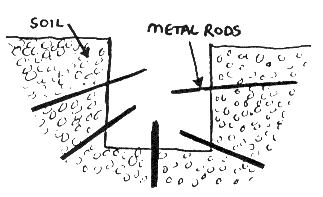 Ground lock-ons:
Ground lock-ons:
Dig a hole and drive metal rods halfway into the surrounding soil from the
hole before pouring the concrete in. Use one of the rods as the cross bar for
the arm tube. Ground lock-ons are best positioned on access routes and at the
base of trees. If you can build it amongst the tree's roots, this will reduce
the area they have to work in.
Multiple arm tubes are more sociable and restrict access to the lock-on,
due to the number of people lying around. Try placing something over a
lock-on, leaving enough room to get your arm to it. Cattle-grids, steel
plates, lorry wheels and dead cars have all been used. To make it even harder,
weld the object to the lock-on.
Alternatively you could build a scaffold / steel bar sculpture, embedded in
concrete, leaving only enough room in between to lock-on. You could use
rotating bars for this sculpture. Place metal bars inside scaffold poles,
packed with grease and ball bearings. Weld the ends to seal them. The rod will
spin inside the pole if they try to cut it with an angle grinder. These bars
could also be embedded in a lock-on. Ground lock-ons in the bottom of a deep,
narrow shaft should force them to dig down to you to before they can attack
the lock-on. Lock on with your feet. One lock-on has been made with
ski-boots!
Tree lock-ons:
Find a sturdy fork in a strong tree. You may need to build a small platform as
a base. Then build the lock-on up the tree, hauling cement up a bucket at a
time. Make it big, or they'll lower you still attached to it. They may chip
some of it away, then lower it. Try and place it somewhere awkward.
Felled tree lock-ons:
With this method, each felled tree returns to haunt them! If doing a single
lock-on, drill a hole the diameter of your arm and a forearm's length into the
thickest part of a felled trunk. To make the hole use a large auger or a
chainsaw (very carefully). Remove the bark gently and use it to conceal the
finished work. Get a steel eye with a strong screw thread on it, e.g. a gate
hinge eye, and screw it into the bottom. Lock onto this.
Alternatively, you could drill all the way through so that two people can
lock their wrists together, in the middle from either side. Reinforce the
trunk by hammering nails and bits of metal around the lock-on. Smaller logs
can be used as a mobile road blocking lock-on.
Some suggest that similar lock-ons in living trees would be effective and
wouldn't kill the tree, but this is very controversial and likely to upset a
lot of people.
Chainsaw-Blocking Tools
If you don't get a chance to teach chainsaws
to fly, or run off with the petrol can, you'll need special tools to stop
them.
Chainsaw Whips:
These are made from frayed synthetic rope or fabric. If flicked at the
chainsaw blade, the whip will catch in the saw teeth, and be dragged into the
drive mechanism. Make sure you let go! The synthetic fibres clog up the drive
mechanism and may melt into it. Note which direction the saw teeth are moving,
so that you whip the correct side.
Gunk Bombs:
Fine grain sand, mixed with wallpaper paste and short lengths of fishing line,
can be used to stuff condoms or balloons. Throw these at chainsaw blades. The
mixture needs to be viscous so that it sticks to the blade when it hits.
Tree-bark Gunking:
Try coating the tree at chainsaw level with sticky biodegradable gunk, such as
molasses. You can embed sand, kevlar pieces (from tree surgeons' protective
trousers) and pieces of wire into the gunk.
Invasive Tree Defence:
There is debate as to whether this is a holistic and nonviolent tactic. Some
feel it harms the tree and causes it pain. Others counter this by saying that
if trees face death, then some damage done trying to protect them is
acceptable. Iron does not kill trees, but copper or brass will poison it.
The safest, and arguably most useful, invasive technique is to wrap the
tree in frayed polyprop covered in stapled-down chicken wire and metal cable,
nailed down corrugated iron and other bits of metal, bitumen, etc. Please
remove it if you win!
Spiking involves driving large nails or similar deep into the tree. See
Ecodefense for methods (Chapter xx). Chainsaw operators might be injured if
their saw unexpectedly hits a spike within a tree, and "kicks back". Some
would argue that this risk does not make this a nonviolent tactic. Unless the
spiking is blatantly obvious, you must have permanent warning signs. The
chainsaw operators would then have to carefully and slowly remove all metal
before starting work. They may use metal detectors for this, so make sure they
know if you're using non-metal spikes (eg. ceramic or plastic).
Spiking has been most effective when used to fight large logging operations
outside Britain, where the developer's goal is to clear-cut forest and process
the timber. Spikes can mangle processing machinery in the saw mill. Where the
objective is to stop trees being trashed rather than to stop their felling for
timber, spiking may not be very effective - especially as many trees are
simply bulldozed here, and usually burnt.
Tripods
Tripods have successfully been used as a mobile,
easily-erected blockade. They are made from easily obtainable materials -
scaffold poles from building sites, or long, straight tree trunks (use their
work against them!). Sustained tripod sits in conspicuous places near major
roads are a good campaign advert and focal point.
For Full instructions there are three images, each about 33K file size.
1 | 2 | 3 They
will download into a new window (probably...)
If you have rope or short scaffold poles fixed about 5 foot from the top of
the tripod, they won't be able to lower the tripod by pulling it's legs apart.
At Newbury in 1996, security guards used a LandRover with a roof rack, which
they reversed in under the tripod apex. They stood on the roof and pulled down
the sitter, after cutting any handcuffs or locks. It may be worth working on
LandRover-proofing; for instance, positioning the tripod so they can't drive
under it, or overlapping the legs of several tripods for mutual protection.
Cherry-pickers have also been used.
Bipods
These haven't been used in Britain, but have successfully
blocked logging roads in the US and Australia. They generally need careful
assembly in advance.
A bipod can be incorporated between two tripods, linked with a rope or
further poles via the apex of each structure. The stability of the bipod
depends entirely on its link to the two tripods. This method defends a larger
area than separate tripods.
Monopoles
These haven't been used much. They can be dug vertically
into the ground and shinned up to create an obstacle. Alternatively, you could
perch them at bizarre angles, fixing one end, to form a cantilever, and dangle
from the free end! There are lots of variations on this basic technique. All
look fairly dangerous.
Scrap Cars
You can buy these very cheaply, and register them with a
false name and address. Be aware that driving an unroadworthy, uninsured,
untaxed car will get you arrested if you're stopped. You can use scrap cars to
quickly blockade a gate, road, motorway, or just about anything. Lock- ons can
be built into the car to make them an even more potent tool, or you can just
lock onto the chassis. To start the blockade, quickly immobilise the car by
slashing tyres, removing wheels, or turning it over.
Caltrops
These are nasty, small, multi-spiked metal objects, designed
so that they always lie with a point upwards. They puncture the tyres of any
vehicle which drives over them, and so can be placed on access roads or tossed
under the wheels. They should only be used on a slow-moving or stationary
vehicle. There are many problems with caltrops. They are dangerous to drivers
if used on a fast-moving vehicle, and to people and animals if trodden on. If
you are caught using or even carrying them, you are likely to be arrested for
possession of an offensive weapon, or perhaps something more serious. Because
they look menacing, the police will happily use them to discredit your
campaign by calling them "weapons". They are not even a particularly reliable
vehicle-stopper, as a tyre can miss them. Therefore, we advise thinking very
carefully before using caltrops at all.
Smoke Bombs.
Reliable smoke distress signals can be bought at boat
jumbles for about £4. (see a copy of Practical Boat Owner magazine).
They billow out loads of thick coloured smoke, and will float on water.
Smaller, cheaper versions can be bought at paintball shops. Set them off
upwind, to hinder an eviction, cover an action, escape, or provide a
diversion. Don't get caught with one, as the police don't like them.
Anti-Quickcuff Gauntlets
Quickcuffs (see Chapter 10) and handcuffs may
be used by police, bailiffs and climbers to catch you during evictions. To
prevent this, try this simple and effective idea. Cut a cardboard strip about
20 cm x 60 cm. Wrap this quite tightly around your wrist and forearm, and tape
it to form a tapering cylinder. Then cut a hole for your thumb, so that you
can hold onto the gauntlet if anyone tries to pull it off.
This book is now out of print. You might be able to get a copy from a UK
library by ordering on the inter-library loans scheme.
Road Alert!
EMAIL: info@roadalert.org.uk
 Bicycle D-locks
Bicycle D-locks
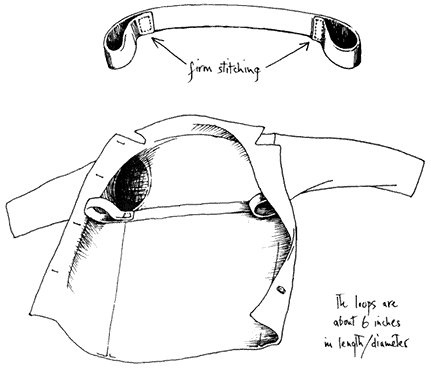
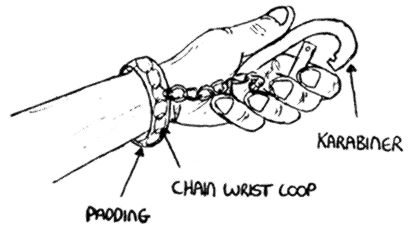
 All lock-ons are constructed from an arm tube, with a metal
crossbar at the bottom, which is then set in concrete. The concrete mix, 1
part cement to 3 parts sandy aggregate, can be strengthened using washing up
liquid. Pieces of chopped-up tyres and metal mesh can be added to the mix to
hinder drilling out the concrete. Surround the cross bar and arm tube with
lots of metal, e.g. a car wheel. The concrete ideally needs months to set to
its full strenght. Make them well in advance. On some campaigns, gas canisters
have been conspicuously embedded in the lock-on, to deter use of power tools.
This has led to the police threatening arrest for explosives offences, so
those lock-ons were dismantled by protesters. When building, plan for a
comfortable locking on position.
All lock-ons are constructed from an arm tube, with a metal
crossbar at the bottom, which is then set in concrete. The concrete mix, 1
part cement to 3 parts sandy aggregate, can be strengthened using washing up
liquid. Pieces of chopped-up tyres and metal mesh can be added to the mix to
hinder drilling out the concrete. Surround the cross bar and arm tube with
lots of metal, e.g. a car wheel. The concrete ideally needs months to set to
its full strenght. Make them well in advance. On some campaigns, gas canisters
have been conspicuously embedded in the lock-on, to deter use of power tools.
This has led to the police threatening arrest for explosives offences, so
those lock-ons were dismantled by protesters. When building, plan for a
comfortable locking on position. If you're making lots of lock-ons over a large area in a short
time, a mobile concreting team with a small mixer might be a sensible way to
organise. Ideally, the person who makes the lock-on should be the person who
uses it. Try to keep the location of lock-ons quiet and perhaps have one show-
piece lock-on to demonstrate to new people.
If you're making lots of lock-ons over a large area in a short
time, a mobile concreting team with a small mixer might be a sensible way to
organise. Ideally, the person who makes the lock-on should be the person who
uses it. Try to keep the location of lock-ons quiet and perhaps have one show-
piece lock-on to demonstrate to new people. Ground lock-ons:
Ground lock-ons: